初三英语语法知识复习
初三英语Unit1-6复习(语法部分)知识精讲

初三英语Unit1-6复习(语法部分)知识精讲【同步教育信息】一. 本周教学内容:Unit 1-6 复习(语法部分)(一)现在完成时(The Present Perfect Tense)1. 动作发生于一个非确定的过去的时间(过去的时间并不重要或根本不知道),但它的结果仍对现在有影响.I have read the letter, and I know what it is about.2. 动作发生在过去,目前仍在继续或刚刚结束,常和“for”加上“一段时间”,或“since”加上“一个确切的过去的时间”连用。
“for”用于过去的一段时间. (动词必须是可以延续的)He has been there for six months. 他去那有6个月了。
(直到现在)He has never been there. 他从来都没去过那里。
(直到现在)“since”用于过去的一个确切的时间,意思是“从那时一直到现在”,总是和完成时一齐用,而且不能省略。
(主句动词必须是可以延续的)since +一段时间+ago;since+一个时间点;since+从句。
如:He has stayed here since 3 hours ago.He has stayed here since 3 o’clock.Tim has been in Nantong since January.自从1月份以来Tim一直都在南通。
(现在仍在南通)注意:“since”后面的确切的过去的时间也可以是一个含有过去时的从句.He has been interested in collecting coins since he was a child.他打小时候起就对收集硬币感兴趣。
(现在还是如此)He has taught English since he came here.现在完成时常和短语“up to now /till now”,“so far”(意思是从过去某一确定的时间一直延续到现在)连用。
初三英语语法基础知识大全

初三英语语法基础知识大全1.初三英语语法基础知识大全篇一动名词(doing)动名词相当于名词,在句子中可以做主语、宾语、表语、定语等。
1. 作主语Fighting broke out between the South and the North.南方与北方开战了。
2. 作宾语Would you mind turning down your radio a little, please?请问你介意调小一点收音机的音量吗?3. 作表语Babysister’s job is washing,cooking and taking care of the children.保姆的工作是洗衣服,作饭和照看孩子。
neither与nor的用法1.如前句是否定式从句,则主句用neither,而不用nor.If you don't do it,neither should I.如果你不干,我也不干.2.如后连续有几个否定句式,则用nor,不用neither.He can't sing,nor dance,nor skate.2.初三英语语法基础知识大全篇二连词及其用法1.连词是一种虚词,它不能独立担任句子成分而只起连接词与词,短语与短语以及句与句的作用。
2.常见的连词and(和,与;而且;于是,然后;因此)but(但是;通常用not...but...不是...而是...;可是,然而;表示惊讶,不同意等--喔,哇;用来加强语句重复部分的语气--一定;用来引入新话题--那就;常用于否定句--而不,若不;用于含doubt,question等字的否定句中相当于that--对于)or(或者,还是;用于否定句或问句--也不;否则,要不然;也就是说,换言之)nor(用在neither之后--也不;用在no,not,never之后--也不;用在句首,句子需倒装--也不)so(因此,所以;因而,从而)yet(可是,却,然而)for(因为,由于)both…and(既...又...;不但...而且)not only…but also(不但,而且)either…or(不是...就是;要么...要么)neither…nor(既不...也不...)3.并列连词:①and 与or;②both …and两者都;③not only…but ...as well as=not only...but also不但…而且;④neither…nor意思为"既不……也不……"谓语动词采用就近原则,与nor后的词保持一致。
初三英语语法知识点
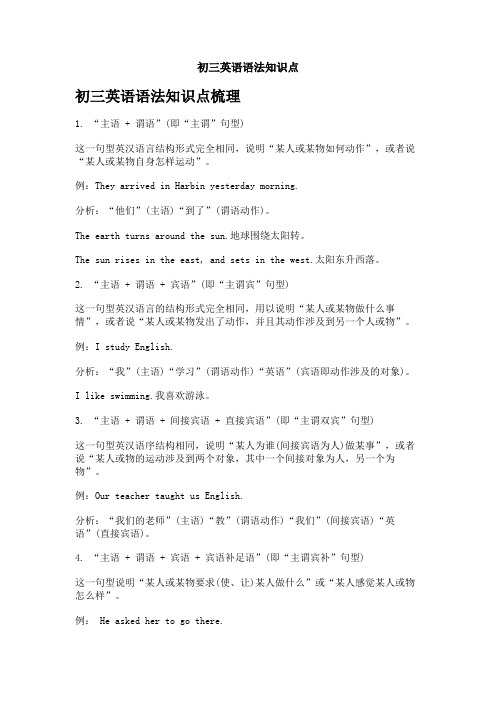
初三英语语法知识点初三英语语法知识点梳理1. “主语 + 谓语”(即“主谓”句型)这一句型英汉语言结构形式完全相同,说明“某人或某物如何动作”,或者说“某人或某物自身怎样运动”。
例:They arrived in Harbin yesterday morning.分析:“他们”(主语)“到了”(谓语动作)。
The earth turns around the sun.地球围绕太阳转。
The sun rises in the east, and sets in the west.太阳东升西落。
2. “主语 + 谓语 + 宾语”(即“主谓宾”句型)这一句型英汉语言的结构形式完全相同,用以说明“某人或某物做什么事情”,或者说“某人或某物发出了动作,并且其动作涉及到另一个人或物”。
例:I study English.分析:“我”(主语)“学习”(谓语动作)“英语”(宾语即动作涉及的对象)。
I like swimming.我喜欢游泳。
3. “主语 + 谓语 + 间接宾语 + 直接宾语”(即“主谓双宾”句型)这一句型英汉语序结构相同,说明“某人为谁(间接宾语为人)做某事”,或者说“某人或物的运动涉及到两个对象,其中一个间接对象为人,另一个为物”。
例:Our teacher taught us English.分析:“我们的老师”(主语)“教”(谓语动作)“我们”(间接宾语)“英语”(直接宾语)。
4. “主语 + 谓语 + 宾语 + 宾语补足语”(即“主谓宾补”句型)这一句型说明“某人或某物要求(使、让)某人做什么”或“某人感觉某人或物怎么样”。
例: He asked her to go there.分析:“他”(主语)“要求”(谓语动作)“她”(宾语即动作涉及的对象)“去那里”(补语—补充说明宾语应做什么)。
5. “主语 + have + 宾语”(即“拥有”句型)这一句型主要用于说明“某人或某物拥有什么(宾语,即有形或无形的资源)”。
中考英语重点语法复习

中考英语重点语法复习被动语态一、基础知识一、各时态被动语态的谓语结构二、含情态动词被动语态的谓语结构Can/must/should/may/might...+be+p.p.二、分知识点例题【例1】.Wuchazi Bridge ________ as an Internet-famous place in Chengdu.A.regards B.is regarded C.is regarding【例2】.Our sports meeting _______ until the end of July.A.puts off B.will put off C.will be put off【例3】.Earth Day ______ in 1970 for the first time, and the Day now includes events in more than 190 countries and regions (地区).A.celebrated B.was celebrated C.is celebrated D.has been celebrated【例4】.When I was young, I ________ by my grandparents.A.look after B.looked after C.am looked after D.was looked after【例5】.A number of volunteers will ________ for the 2022 Beijing Winter Olympic Games. A.be needed B.are needed C.are needing D.be needing【例6】.—Tom is always careless with his schoolwork.Could you help him?—No problem!I think he _______ to think twice before starting.A.should be told B.shouldn't be told C.should tell三、巩固训练1.As soon as books ________, the volunteers posted them to the students in Hope Primary School. A.are raised B.were raised C.raised D.have raised2.—Did you notice the students ________ a few why questions in Mr. Zhang’s class?— Yes, I think he wanted to train their abilities of deep thinking.A.are asked B.must be asked C.have been asked D.were asked3.The play Teahouse ________ by the famous Chinese writer Lao She.A.wrote B.was writing C.was written4.Now waste from daily life in the city of Shanghai ________ to be separated into four different groups.A.is requiring B.is required C.was required D.required5.— Why have I never seen this kind of 5G mobile phone?— Because it ___________ by Huawei last week.A.was produced B.would produce C.have produced D.was producing 6.—Sir, I have trouble doing the voluntary work for the 20th Games of Jiangsu Province in Taizhou. —Don’t worry. A lot of support ________ soon.A.is offered B.will be offered C.was offered D.were offered7.The blender________ for making a banana milk shake just now.A.will be used B.was used C.is used8.—How clean your bike is! —Thank you. It ________ very often.A.is washed B.washes C.was washing D.washed9.It is reported that the new robot ________ by a middle school student three years ago. A.invented B.invents C.was invented D.is invented10.—China is getting stronger and stronger. —Yes. So Chinese________ by more and more foreigners.A.learn B.learned C.is learned D.was learned11.Where we should go ________ next Friday.A.is decided B.was decided C.will be decided D.has been decided12.With the development of China, Chinese __________ by more and more people in the world. A.speaks B.is spoken C.speak D.is speaking13.Our school library ________ with plants, lovely desks and chairs, so I feel relaxed while studying or reading there.A.decorates B.decorated C.is decorated D.was decorating14.If the rivers __________, farmers can’t use the water for their crops.A.polluted B.were polluted C.are polluting D.are polluted15.In the year of 2020, each of us ________ by the people like Zhong Nanshan and Li Lanjuan who taught us how to fight against the difficulties in life with a strong will.A.were greatly encouraged B.greatly encouragesC.greatly encouraged D.was greatly encouraged16.China Panda Train from Chengdu to Zunyi _________ to use on March 28, 202l.A.is put B.was put C.will be put D.putsst year Huai'an Flyover(高架) _________. Now it brings much convenience to people. A.finished B.finishes C.is finishing D.was finished18.Many comic books ______ into cartoons in the past 40 years.A.make B.are made C.have make D.have been made19.—I hate sweeping the floor.—Why not buy a sweeping robot? It ________ widely nowadays.A.use B.is used C.was used D.used20.So far this year, many new houses ________ in Wenchuan with the help of the government. A.build B.are built C.will build D.have been built21.These great books ________ by people all over the world today.A.were read B.read C.are read22.How delicious the cake is! It_____________ by my grandmother this morning.A.made B.is made C.was made23.That machine is broken. It ________ tomorrow.A.repaired B.was repaired C.will repair D.will be repaired24.To celebrate the 100th birthday of the Communist Party of China, a speech competition________ in our school last week.A.hold B.held C.is held D.was held25.Fishing _________ in order to protect the ecosystem of Hanjiang River.A.allows B.is allowed C.isn’t allowed D.won’t allow26.A 3-kilometer-long bridge ________ in our hometown three years ago.A.has built B.is built C.was built27.—Can you go out with me tonight?—Sorry, my mother won’t allow me to go out unless my homework __________.A.will be finished B.was finished C.finishes D.is finished28.The Monkey King is a traditional Chinese cartoon hero. Today, he ________ by people of all ages.A.will love B.was loved C.is loved D.will be loved29.In the big earthquake of Gansu, people ______ to the safe places by the army.A.take B.took C.were taken30.In our English class, many chances ________ to students to show themselves.A.offer B.are offered C.offered D.are offering31.Our plan to have a graduation ceremony_____in the next class meeting.A.was discussed B.will discuss C.is discussed D.will be discussed32.As the most exciting and traditional way to shop, street markets __________here and there in China these days.A.find B.found C.are found D.were found33.—Our school sports meeting ___________ next week. Which sport will you take part in? —The long jump and the high jump. I'm good at jumping.A.holds B.held C.was held D.will be held34.—What’s wrong with Dale? — He ___________ with others in his class just now. He’s not happy about that.A.is compared B.was compared C.compares D.compared35.I think e-books will _______more than paper books in the future.A.use B.be used C.used36.— Do we have to read anything next week, Mr Wu?— Sure, You ________ to read Black Beauty from pages 58 to 85.A.were expected B.will expect C.are expecting D.are expected37.— Lily, cars are increasing very fast nowadays.— Actually, lots of convenience (方便) ________ for us.A.provided B.provided C.is provided38.—The last Beidou GEO-3 ______ into space successfully on June 23, 2020.—As Chinese, we feel proud of it.A.sends B.sent C.is sent D.was sent39.—Mr. Wang is very famous in our school.—That's for sure. He ________ by reporters tomorrow.A.interviews B.interviewed C.is interviewed D.will be interviewed40.Our sports meeting _______ until the end of July.A.puts off B.will put off C.will be put off41.Now teenagers ________ to do voluntary work for their local commodities.A.are encouraged B.were encouraged C.have encouraged D.are encouraging 42.—_________ the Communist Party of China (中国共产党) founded in 1921?—Yes, and it’s her 100th birthday this year.A.Is B.Was C.Has D.Have43.—Every year, millions of plastic bottles ________ away, polluting the land and waterways. —That’s terrible. We should protect our environment.A.threw B.are thrown C.have thrown D.were thrown44.Rainbows ________ when sunlight passes through small drops of water in the sky. A.produce B.produced C.are produced D.were produced45.—Will you go to Lisa's housewarming party next Sunday? —Well, if I________, I will go on time.A.invite B.will invite C.am invited D.will be invited46.“I’m still working because I’m still capable and hope to guide more young people,” said Wu Mengchao when he _______.A.is interviewed B.is interviewing C.was interviewed D.was interviewing47.Today, many winter Olympic sports ________ even by children.A.enjoyed B.enjoy C.were enjoyed D.are enjoyed48.—What do you know about the earthquake happened in the morning? —The wounded people ________ to the hospital in time.A.are brought B.were brought C.will be brought49.—Students begin to pay more attention to subjects of art education.—That’s true. They ________ in senior high school entrance examination.A.are tested B.were tested C.will be tested50.Chinese tea is very popular, and it ________ to many different parts of the world.A.is sent B.sends C.has sent51.A lot of teenagers think as they are older and wiser, they ________ to make their own decisions.A.should allow B.shouldn’t allow C.should be allowed D.shouldn’t be allowed 52.No matter how many difficulties we have, I believe all the problems can ________ in the end. A.solve B.be solved C.answer D.be answered53.—What do you think of the games on the internet?— I think they _________ for students during the weekdays.A.should be closed B.are closed C.closed D.were closed54.Some people think trees ________ on Tree Planting Day only.A.should plant B.should be plant C.shouldn’t be planted D.should be planting 55.Some people think trees________on Tree Planting Day only.A.should plant B.should be plant C.should be planted56.—What can we do to protect our environment, Laura?—To make our city more beautiful, rubbish _______ into the river.A.needn’t be thrown B.mustn’t be thrown C.can’t throw D.may not throw 57.The young tree ________ well when it is planted.A.mustn’t watered B.should be watered C.must water D.should water58.We’ll have a birthday party for the child. A pet dog ______ to him as a gift.A.may give B.may be given C.must give D.must be given59.More dinosaur fossils(化石), including footprints, bones or eggs, could ________ in the future. A.discover B.be discovered C.have discovered D.be discovering60.These days, Health Code should ________ before entering public places.A.show B.be shown C.be showing【参考答案】【例1】B 【例2】C 【例3】B 【例4】D 【例5】A 【例6】A巩固练习1.B2.D3.C4.B5.A6.B7.B8.A9.C 10.C11.C 12.B 13.C 14.D 15.D 16.B 17.D 18.D 19.B 20.D21.C 22.C 23.D 24.D 25.C 26.C 27.D 28.C 29.C 30.B31.D 32.C 33.D 34.B 35.B 36.D 37.C 38.D 39.D 40.C41.A 42.B 43.B 44.C 45.C 46.C 47.D 48.B 49.C 50.A51.C 52.B 53.A 54.C 55.C 56.B 57.B 58.B 59.B 60. B。
初中英语语法知识点总结及练习
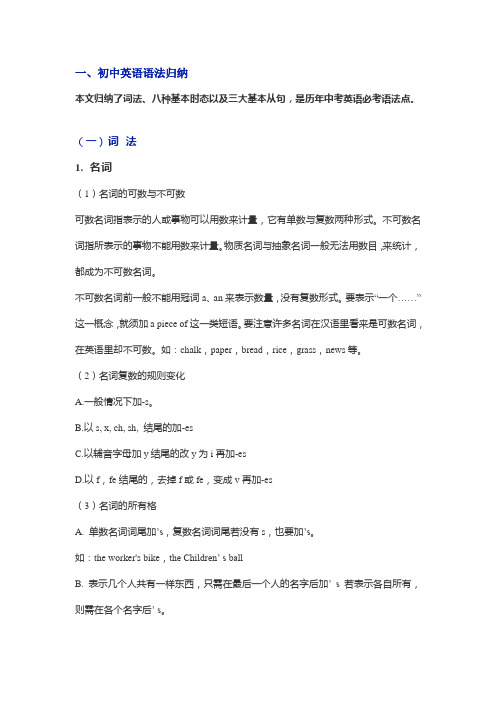
一、初中英语语法归纳本文归纳了词法、八种基本时态以及三大基本从句,是历年中考英语必考语法点。
(一)词法1. 名词(1)名词的可数与不可数可数名词指表示的人或事物可以用数来计量,它有单数与复数两种形式。
不可数名词指所表示的事物不能用数来计量。
物质名词与抽象名词一般无法用数目,来统计,都成为不可数名词。
不可数名词前一般不能用冠词a、an来表示数量,没有复数形式。
要表示“一个……”这一概念,就须加a piece of这一类短语。
要注意许多名词在汉语里看来是可数名词,在英语里却不可数。
如:chalk,paper,bread,rice,grass,news等。
(2)名词复数的规则变化A.一般情况下加-s。
B.以s, x, ch, sh, 结尾的加-esC.以辅音字母加y结尾的改y为i再加-esD.以f,fe结尾的,去掉f或fe,变成v再加-es(3)名词的所有格A. 单数名词词尾加’s,复数名词词尾若没有s,也要加’s。
如:the worker's bike,the Children’ s ballB. 表示几个人共有一样东西,只需在最后一个人的名字后加’ s若表示各自所有,则需在各个名字后’ s。
如:This is Lucy and Licy’ s room.These are Kate's and jack’ s rooms.C. 如果是通过在词尾加—s构成的复数形式的名词,只加’。
如:the students’ books,the girls’ blouses(另外:名词+of+名词名词是有生命的,我们就用’s结构来表示所有关系。
如果名词所表示的事物是无生命的,我们就要用名词+of+名词的结构来表示所有关系。
) 2. 代词人称代词,物主代词,反身代词,指示代词,不定代词(1)人称代词第一人称单数I me my mine myself复数 we us our ours ourselves第二人称单数 you you your yours yourself复数 you you your yours yourselves第三人称单数 he him his his himselfshe her her hers herselfit it its its itself复数 they them their theirs themselves(2)物主代词物主代词的用法:形容词性物主代词后面一定要跟上一个名词;名词性物主代词可作主语、表语、宾语。
九年级英语语法知识点汇总
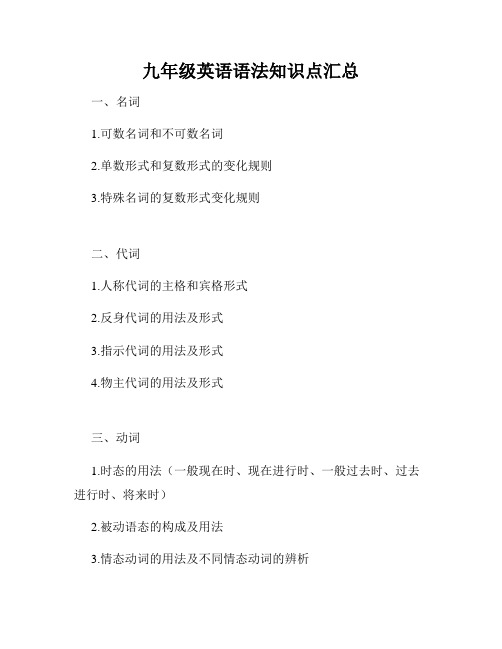
九年级英语语法知识点汇总
一、名词
1.可数名词和不可数名词
2.单数形式和复数形式的变化规则
3.特殊名词的复数形式变化规则
二、代词
1.人称代词的主格和宾格形式
2.反身代词的用法及形式
3.指示代词的用法及形式
4.物主代词的用法及形式
三、动词
1.时态的用法(一般现在时、现在进行时、一般过去时、过去进行时、将来时)
2.被动语态的构成及用法
3.情态动词的用法及不同情态动词的辨析
四、形容词和副词
1.形容词的基本用法及比较级和最高级的构成
2.副词的基本用法及比较级和最高级的构成
3.形容词和副词的位置
五、介词和介词短语
1.常用介词的用法及常见短语的搭配
2.介词短语的位置和作用
六、连词和并列句
1.连词的分类和用法(并列连词、从属连词、对等连词)
2.并列句的构成及注意事项
七、从句和复合句
1.名词性从句的种类和用法(主语从句、宾语从句、表语从句)
2.定语从句的构成及引导词的使用
3.状语从句的分类及引导词的使用
八、倒装句和间接引语
1.完全倒装句和部分倒装句的构成及使用场景
2.直接引语和间接引语的转换
九、复习与补充
1.重点复习前面九个年级所学的语法知识点
2.补充其他有关九年级英语语法的知识
以上是九年级英语语法知识点的汇总,希望能帮助到你对这些知识点的理解和掌握。
在学习过程中,请多做练习和总结,以提高自己的语法能力。
祝你学习顺利!。
初三英语语法知识点总结归纳
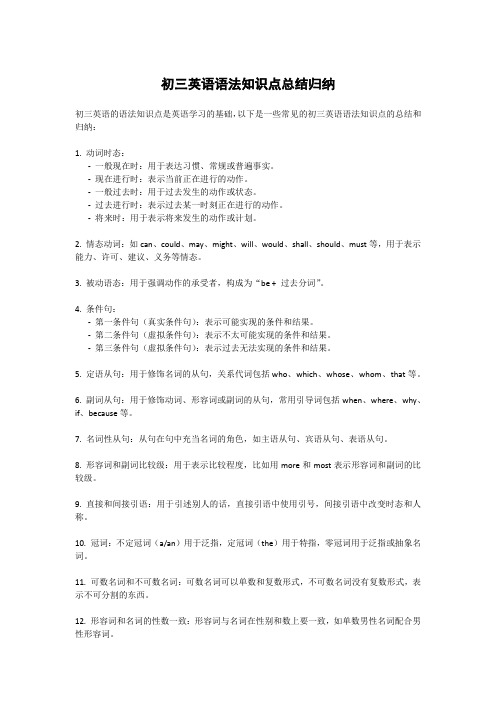
初三英语语法知识点总结归纳初三英语的语法知识点是英语学习的基础,以下是一些常见的初三英语语法知识点的总结和归纳:1. 动词时态:-一般现在时:用于表达习惯、常规或普遍事实。
-现在进行时:表示当前正在进行的动作。
-一般过去时:用于过去发生的动作或状态。
-过去进行时:表示过去某一时刻正在进行的动作。
-将来时:用于表示将来发生的动作或计划。
2. 情态动词:如can、could、may、might、will、would、shall、should、must等,用于表示能力、许可、建议、义务等情态。
3. 被动语态:用于强调动作的承受者,构成为“be + 过去分词”。
4. 条件句:-第一条件句(真实条件句):表示可能实现的条件和结果。
-第二条件句(虚拟条件句):表示不太可能实现的条件和结果。
-第三条件句(虚拟条件句):表示过去无法实现的条件和结果。
5. 定语从句:用于修饰名词的从句,关系代词包括who、which、whose、whom、that等。
6. 副词从句:用于修饰动词、形容词或副词的从句,常用引导词包括when、where、why、if、because等。
7. 名词性从句:从句在句中充当名词的角色,如主语从句、宾语从句、表语从句。
8. 形容词和副词比较级:用于表示比较程度,比如用more和most表示形容词和副词的比较级。
9. 直接和间接引语:用于引述别人的话,直接引语中使用引号,间接引语中改变时态和人称。
10. 冠词:不定冠词(a/an)用于泛指,定冠词(the)用于特指,零冠词用于泛指或抽象名词。
11. 可数名词和不可数名词:可数名词可以单数和复数形式,不可数名词没有复数形式,表示不可分割的东西。
12. 形容词和名词的性数一致:形容词与名词在性别和数上要一致,如单数男性名词配合男性形容词。
13. 反身代词:用于表示某人做某事而影响到自己的代词,如myself、yourself、himself、herself、itself、ourselves、yourselves、themselves。
初中英语总复习知识点归纳(基本全了)
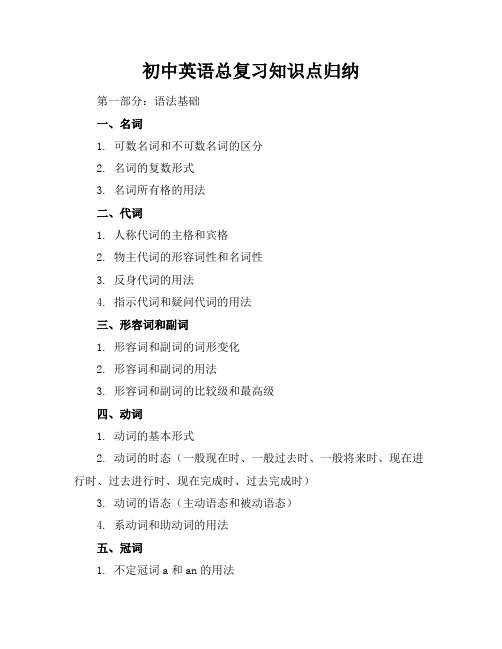
初中英语总复习知识点归纳第一部分:语法基础一、名词1. 可数名词和不可数名词的区分2. 名词的复数形式3. 名词所有格的用法二、代词1. 人称代词的主格和宾格2. 物主代词的形容词性和名词性3. 反身代词的用法4. 指示代词和疑问代词的用法三、形容词和副词1. 形容词和副词的词形变化2. 形容词和副词的用法3. 形容词和副词的比较级和最高级四、动词1. 动词的基本形式2. 动词的时态(一般现在时、一般过去时、一般将来时、现在进行时、过去进行时、现在完成时、过去完成时)3. 动词的语态(主动语态和被动语态)4. 系动词和助动词的用法五、冠词1. 不定冠词a和an的用法2. 定冠词the的用法3. 不使用冠词的情况六、连词1. 并列连词的用法2. 从属连词的用法七、介词1. 常用介词的用法2. 介词短语的结构和用法八、数词1. 基数词和序数词的用法2. 分数、小数和百分数的表达九、感叹词1. 感叹词的用法十、疑问词1. 疑问词的用法十一、句型结构1. 简单句的五种基本句型2. 并列句和复合句的结构和用法十二、主谓一致1. 主谓一致的原则2. 主谓一致的特殊情况十三、倒装句1. 完全倒装和部分倒装的区别2. 常见的倒装句型十四、省略句1. 省略句的结构和用法十五、强调句1. 强调句的结构和用法十六、虚拟语气1. 虚拟语气的用法十七、情态动词1. 情态动词的用法十八、非谓语动词1. 非谓语动词的分类和用法十九、固定搭配1. 常见的固定搭配二十、习惯用语和俚语1. 常见的习惯用语和俚语第二部分:词汇与短语一、词汇记忆方法1. 词根词缀记忆法2. 同义词和反义词记忆法3. 分类记忆法4. 联想记忆法二、常见词汇和短语1. 常用动词短语2. 常用形容词短语3. 常用介词短语4. 常用连词短语5. 常用固定搭配三、词汇辨析1. 形近词辨析2. 意思相近的词辨析3. 语境辨析四、词汇应用1. 词汇在句子中的应用2. 词汇在段落中的应用3. 词汇在文章中的应用五、词汇扩展1. 通过阅读扩展词汇2. 通过听力扩展词汇3. 通过口语和写作扩展词汇六、词汇复习策略1. 制定词汇复习计划2. 定期进行词汇测试3. 反复记忆和复习第三部分:阅读理解一、阅读技巧1. 快速阅读2. 精读3. 猜词技巧4. 理解文章主旨和大意5. 找出文章中的细节信息二、阅读题型1. 主旨大意题2. 细节理解题3. 推理判断题4. 词义猜测题5. 观点态度题三、阅读材料1. 故事类文章2. 议论文3. 说明文4. 应用文5. 新闻报道四、阅读理解策略1. 预览文章和首段2. 扫读文章找出关键词3. 仔细阅读理解文章内容4. 回答问题时注意关键词和语境5. 验证答案是否符合文章内容第四部分:写作技能一、写作技巧1. 确定写作目的和主题2. 拟定写作提纲3. 运用适当的句型和词汇4. 保持文章逻辑清晰5. 注意文章格式和标点符号二、写作题型1. 记叙文2. 议论文3. 说明文4. 应用文5. 日记和书信三、写作素材1. 人物描写2. 地点描写3. 事件描写4. 情感表达5. 观点陈述四、写作策略1. 多读优秀范文2. 多练习写作3. 请教老师和同学4. 反复修改和润色5. 保持写作兴趣和热情第五部分:听力理解一、听力技巧1. 预测听力内容2. 抓住关键词和关键信息4. 边听边记笔记5. 理解对话和独白的逻辑关系二、听力题型1. 简单听力理解题2. 听力细节理解题3. 听力推理判断题4. 听力主旨大意题5. 听力词义猜测题三、听力材料1. 对话2. 独白3. 新闻报道4. 广播节目5. 电影和电视剧片段四、听力理解策略1. 预览问题和选项2. 仔细听录音,注意关键词3. 根据听力内容进行推理和判断4. 选择最符合听力内容的答案5. 检查答案是否符合题意第六部分:口语表达一、口语技巧1. 准备话题和内容3. 保持语速适中4. 注意语法和词汇的准确性5. 保持自信和流畅二、口语题型1. 自我介绍2. 话题讨论3. 角色扮演4. 观点陈述5. 回答问题三、口语素材1. 日常生活话题2. 学校生活话题3. 社会热点话题4. 个人兴趣爱好话题5. 旅游和文化话题四、口语表达策略1. 多听多说,提高口语能力2. 模仿优秀的口语表达3. 与老师和同学进行口语练习4. 参加英语角和口语比赛5. 记录自己的口语表达,进行反思和改进第七部分:综合技能一、综合技巧1. 综合运用语法、词汇、阅读、写作、听力和口语等技能2. 注重语言的实际运用能力3. 提高语言的综合运用水平4. 培养跨文化交际能力5. 保持学习英语的兴趣和动力二、综合题型1. 完形填空2. 阅读理解3. 写作4. 听力理解5. 口语表达三、综合复习策略1. 制定综合复习计划2. 定期进行综合测试3. 反复练习和复习4. 请教老师和同学5. 保持学习英语的兴趣和热情。
- 1、下载文档前请自行甄别文档内容的完整性,平台不提供额外的编辑、内容补充、找答案等附加服务。
- 2、"仅部分预览"的文档,不可在线预览部分如存在完整性等问题,可反馈申请退款(可完整预览的文档不适用该条件!)。
- 3、如文档侵犯您的权益,请联系客服反馈,我们会尽快为您处理(人工客服工作时间:9:00-18:30)。
初三英语语法知识专题复习一、名词一、总的来说,名词分为专有名词和普通名词两类. 专有名词:用来表示某个(些)人、地方、机构等专有名称的词。
如Marx、Beijing、USA等,其中的实词第一个字母要大写。
如the Great Wall等。
二、名词按其所表示的事物的性质分为可数名词与不可数名词。
1、可数名词(个体名词和集体名词):(1)单数(前加a或an表“一”); (2)复数(词尾加“-s”或“-es”)。
其规则如下:A.规则变化:(1、以s、x、sh、ch结尾的,加-es / iz /; 如boxes, glasses, watches, brushes等;(2、以“辅音字母+y”结尾的,变y为i,加-es; 如families, babies, countries等;(3以f、fe结尾的,变f、fe为v,加-es; 如knives, wives, halves等;(4、以“辅音字母+o”结尾的,加-es; 如potatoes, tomatoes等,但外来词和缩写词只能加-s,如pianos, kilo(kilogram)——kilos, photo(photograph)——photos.而zero——zeros/zeroes.(5、一般情况加-s,清辅音后发/s/,如desks, maps等,浊辅音和元音后发/z/.如apples, holidays, boys。
但houses/′hauziz/, mouths/mau z/.B.不规则变化(child---children man----men woman---women policeman----policemen foot—feet tooth---teeth mouse---mice)(复数名词: people police shoes public clothes)(1、单数、复数形式相同的:sheep, deer, fish, Chinese, Japanese等。
(2、表示民族、国家的名词,除Chinese, Japanese的复数不变,Englishman, Frenchman的复数变-man 为-men外,其余的均在词尾加-s.如Americans, Germans,Russians, Australians(附某国、某国人、某国语言的词形联系表).→→→→→→→(3、复合名词复数的构成方法①在中心词上加-s或-es, 如:pencil-boxes.②在第二个组成部分上加-s或-es, 如:boy-friends,tooth-brushes等.③含性别的复合词,两部分都变为复数,如:man-teacher——men-teachers, woman-driver——women-drivers.2、不可数名词(抽象名词和物质名词):不能以数目来计算的名词。
如water, meat, rice, air, food, time, work, bread等等。
它们只有单数形式,不能在前面加a(an)或数词来表示一个或几个。
只能用“of词组”来表达。
如“五块肉”five pieces of meat,“三袋小麦”three bags of wheat,“四则新闻”four pieces of news.3等等。
三、名词的所有格(含义“……的”)1、基本构成方法: (1)以s结尾的名词,其所有格只加“′”。
如the students’ teacher the twins’ bedroom. 但以s结尾的单数名词,也可在词尾加“′s”。
如Ross’s bag. (2)其他情况加“’s”。
如:Jane’s father,Women’s Day2、其他规则:(1)并列名词的所有格:①共同所有,只需在最后一个名词词尾加-’s,如:Kate and Joan’sroom.②分别所有,则在每个名词词尾加-’s,如Kate’s and Joan’s.(2)表示无生命的事物名词,一般用of表示所属关系。
如:the map of China, the legs of the table.(3)双重所有格:①用of结构与名词所有格-’s结合构成双重所有格:a friend of my father’s, one book of his brother’s.②用of结构加名词性物主代词构成双重所有格:a pen of mine, a neighbour of his.(4)表示时间、距离、城镇、国家等的名词常用-’s形式:an hour’s walk, yesterday’ news, China’s population, twenty minutes’ walk.(5)可用-’s表示店铺、某人家:the Gree ns’, my uncle’s.典例() 1.This is ____ news. A.such a good B.a very good C. such good()2. _____ knowledge of space develops very quickly. A.People’s B.Man’s C.Men’s ()3. The number of people invited to the party _____ fifty, but a number of them ____ absent for different reasons. A. was/were B. was /was C. were/were()4. “Would you like ___?” “____, please.”A. a drink/ A coffeeB. drink/A cup of coffeeC. a cup drink/A cup coffee()5. Two thirds of the work ____ done. A. are B. is C. have ()6.The rich ____ not always happy. A. is B. have C. are()7. She is the only one of the ____ writers who _____ stories for children.A. woman/writesB. women/writesC. women/write()8. I met him at _____. A.Mr. Green’s B.the Greens C.Greens’()9.Playing football is _____. A.a great fun B.great funs C.great fun()10.The sheep on the hill _____ theirs. They are all white. A.is B.was C.are 提高训练一、用所给名词的正确形式填空:1.My shirt is much cheaper than ________.(John)2.The girl in red is ______________ (Tom and Kate)3.The _________ (Brown) are watching TV now.4.Our school is about ten __________ (minute) walk.5.March 8 is _______________ (woman day).6.Who won the _________ (boy) 400- _______ (meter) race?7.This is ___________ (today) newspaper. 8.There are twenty-five _________ (man) workers in my factory.9.I like ___________ (chicken) very much. T hey’re lovely. So I never eat _________ (chicken).10.Although he is a thirty- ___________ (year old) man, you can see few ________ (hair) on the head.二、冠词一、冠词的种类:不定冠词a(an), 定冠词the。
冠词不能单独使用,必须置于名词前。
二、不定冠词的用法:一般用于单数名词前,表泛指。
其中a用于读音以辅音开头的词前,an用于读音以元音开头的词前。
如1如:(1)I bought a new book. (2)He met an old woman on the way to school.2、表示人或物的某一类。
如:(1)I’m a boy. (2)Would you like an orange?3、表示数量“一”,但没有one强。
如:(1)She has a pencil.(侧重pencil, 而非其他物品) (2)She has one pencil.(侧重数量“一支”,而非“两支、三支”)4、表示“每一”,相当于every。
如:They go to see the old man once a week.5、用于带修饰的抽象名词之前,表示“一种”。
如:That’s a great surprise to her.6、指某人或某物,但不具体说明何人、何物。
如:A boy is waiting for you.7、用于固定搭配词组中。
如:a lot of, a little, a piece of.三、定冠词的用法:定冠词在单复数可数名词和不可数名词前都可使用,表特指,有“this/that或these/those”之意。
1、特指某人或某物。
The man under the tree is his father.2、指上文提到过的人或物。
I bought a new book yesterday. The book is very useful.3、指说话双方都提到过的人或物。
A: Where is the dirty sock, Tom? B: It’s on the bed, mum.4、表示世界上独一无二的事物。
the sun, the moon, the earth.5、用于序数词或形容词最高级前。
(1)He is the tallest boy in our class. (2)The first lesson is about English name.6、用于姓氏复数前,表“……一家人”。
the Blacks, the Wangs.7、用于单数名词前,表一类人或物。
